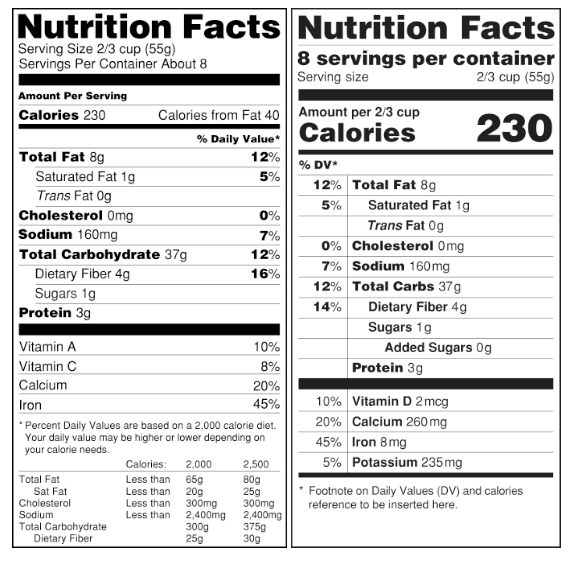How often do you read the “Nutrition Facts” label before making a choice about what to eat? The purpose of the nutrition facts label is to help consumers make healthier choices. You may opt for a brand of wheat bread because it contains more fiber than another, or you may prefer a can of soup with less sodium. The problem with today’s food label is that the information provided is not easily understood and may even be misleading.
The Nutrition Facts panel made its appearance on food packaging in 1994, following the passage of the Nutrition Labeling and Education Act of 1990. Since that time, the decision to include trans fat content has been the only significant improvement, until now. On February 27, First Lady Michelle Obama unveiled the new Nutrition Facts label at the White House, following the announcement by the U.S. Food and Drug Administration (FDA) that revisions had been proposed.
The new label will require food manufacturers to identify the amount of sugar added to their product. The sugars on the current label represent both added sugars and natural sugars, the kind found in fruit and dairy products. Serving sizes will be updated to reflect what consumers actually eat. For example, an entire bag of chips, may become a serving size, which will eliminate the need for a consumer to multiply the number of calories by 2.5 in order to determine how many calories are in the whole bag. Alternatively, larger packages may have two columns of nutritional information, one representing a serving and the other representing the package. Vitamin D and potassium must be declared while vitamins A and C will no longer be required, a change that reflects the nutrients Americans currently don’t get enough of.
Here are the original and proposed Nutrition Facts labels taken from the FDA website:

For 90 days the FDA will accept public comment on the proposed changes. The Student Dietetic and Food Science Association (SDFSA) on campus is encouraging members to submit their opinions. SDFSA Legislative Officer Anjali Prasertong said, “I think it is important to comment on FDA proposals because it gives students, particularly nutrition and food science students, the opportunity to utilize the knowledge they have learned so far in school to form an opinion on an important topic and support that opinion with scientific evidence.” In February, the SDFSA campaigned members to comment on the FDA’s proposal to remove the “generally recognized as safe” designation from trans fats. Research has definitively linked trans fats, otherwise known as partially hydrogenated oils, to cardiovascular disease.
“Once we graduate and start working, we will be expected to help the public understand complex issues related to food science and nutrition,” Prasertong said. “Submitting comments to the FDA is a great way to practice the skills we will need in our future careers.”
If you have an opinion you’d like to share with the FDA, the SDFSA provides a link on their website.
Amanda Blake is a Peer Nutrition Counselor on campus. Peer nutrition counseling is a complimentary service available to students. To make a confidential appointment, contact the Klotz Student Health Center at (818) 677-3666.





